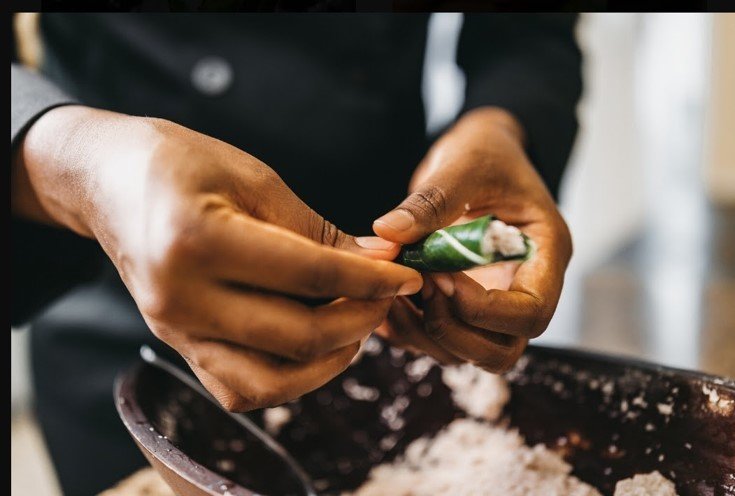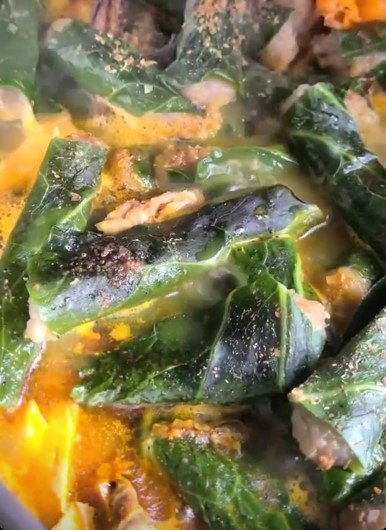Let's Wrap Ekwang/Ekpang and not Kwacoco
Five Tips for Cooking the Perfect Finger-licking Ekwang/Ekpang
Tip Number One
The Cocoyam
Know the difference between White and Red Makabo Cocoyams.
Why?
Generally, red makabo cocoyams have a lower water content than white makabo cocoyams. This makes a red makabo cocoyam to have a dry texture than white makabo cocoyam. The use of red or white makabo cocoyams depends on the dish you are cooking. Sometimes, to reach a certain consistency for a particular recipe, you may mix both cocoyams. This is especially the case when making Ekwang here in the United States. Since the cocoyams imported from other countries have different textures, make sure to experiment with this tip to see how the cocoyams in your country are in texture and water content so that your mixture is neither too watery nor too dry.
How to check for the difference
Peel the fibers off the bottom of the cocoyams to spot the difference in color. Red makabo cocoyams have a more reddish color that white makabo cocoyam.
Tip Number Two
Aerate the Cocoyam Paste
Why?
Aerate the grated cocoyam paste by continuously beating to reach a fluffy texture. Do this every now and then as you are wrapping your Ekwang to keep it in a moist and fluffy consistency.
Aerate the Cocoyam Paste
To achieve a good cocoyam paste consistency, I used both the white and red makabo cocoyams when cooking Ekwang.
Tip Number Three
The Leaf
Know the Type of Leaf to use for Wrapping the Ekwang
Why?
The type of leaf you choose to wrap your Ekwang and how you cook it can not only severely affect the taste but your health as well. Traditionally, the red makabo cocoyam leaf is preferred in wrapping Ekwang. Others prefer to use Igbo cocoyam leaf. Igbo cocoyam leaves are very soft and tend to dissolve when cooking and do not hold the Ekwang very well. Here’s how to solve this problem. If these are the only leaf options available to you, you can still use them as long as you cook thoroughly (meaning the leaves are tender and completely changed in color from green to brown).
Makabo Cocoyam Leaves
Igbo Cocoyam Leaves
Substitute Leaves
To avoid the possibility that the cocoyam leaves itchy allergic reaction may arise when cooking Ekwang, you can use collard greens, turnip greens or leafy spinach. I prefer collard green leaves as they hold the Ekwang rolls very well during the cooking process. If you choose to use collard greens, after fixing the leaves, sit the collard greens in hot boiling water for about 3 minutes and then drain so the leaves become pliable. If you miss this step and go straight into wrapping the cocoyam paste into the leaves, you will find it extremely difficult as collard greens are very stiff and can snap when wrapping. This will cause the cocoyam paste to wash out of the leaves during the cooking process.
Collard Greens
Turnip Greens
Leafy Spinach
Tip Number Four
Let's Wrap Ekwang/Ekpang and NOT Kwacoco
Why?
One key delicious characteristic of Ekwang is maintaining the finger-like shape when the Ekwang it’s cooked. What we say in pidgin "That Ekwang Commot One-One." While this is the hope of many cooks, it can sometimes be a culinary disaster.
Disaster Number One -The Ekwang is Mushy (Potoh- Potoh). This can happen because there is not enough cocoyam paste in the leaves. (Leaf big pass quantity of the cocoyam paste). This causes the cocoyam paste to wash out of the leaves during the cooking process causing the Ekwang to become mushy.
Disaster Number Two - The Ekwang Rolls are too Bigggggg! When the size of the cocoyam leaf is very big, there is a tendency to use a lot of cocoyam paste when wrapping the Ekwang. This will cause the Ekwang rolls to become very biggggg. What my Oroko family would say " This one na Kwacoco nobi Ekwang." When this happens, the Ekwang may not cook properly (Ekwang no go done) which may be dangerous in causing food allergic reactions (Coco/leaf scratch). The Ekwang will also become Mushy (Potoh-Potoh).
Let's Get it Right
Now let's get that perfect finger-like shape. The first step is to ensure that you have enough cocoyam leaves to wrap the Ekwang. When fixing the cocoyam leaves, cut the leaves into palm-size pieces. Scoop about a teaspoon of the cocoyam paste onto a piece of the cut leaf and wrap tightly by rolling the leaf with your fingers. Repeat the process until all the cocoyam paste is finished.
Tip Number Five
Palm Oil
Know When to add Palm Oil into the Pot of Ekwang
Why?
You fry this Ekwang, whoside soup? If someone has asked you this question before, then it's time to correct this culinary mistake. We know that the first time oil is introduced in the Ekwang recipe is when you grease the bottom and the side of the pot with palm oil before wrapping and placing the Ekwang into the pot. After the wrapping is completed, the pot is placed on the fire for the cooking to begin. The next step is where the mistake occurs. From my observations, many home cooks who are not familiar with the Oroko traditional method of cooking Ekwang will add water, additional oil, and other ingredients in the pot then cook it until the pot comes to a boil.
The Problem
When the pot comes to a boil, the water evaporates allowing the oil to settle. The oil then begins to fry the Ekwang. The outcome is a pot of dry, oily, thick Ekwang and in some cases not properly cooked. Uncooked cocoyams and cocoyam leaves have a chemical called calcium oxalate in them that can cause itchiness in the mouth when eaten and severe allergic reactions.
Let's Correct the Mistake
Now let's get it right. To know when to add palm oil into your pot of Ekwang click on the link below for our Ekwang recipe. Our step by step recipe with visual instructions will provide solutions to the culinary challenges you are facing when cooking Ekwang. It's always my pleasure to cook along with you as we celebrate the rich culinary culture of Cameroon.












